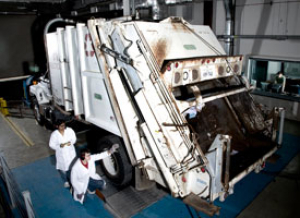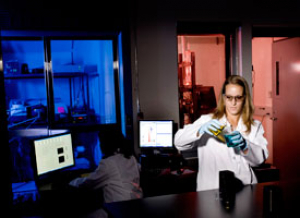Facility Capabilities
Vehicle Testing

The 500hp AC chassis dynamometer test cell, of which there are only a handful of in the United States, gives us the capability to drive vehicles under controlled environment while simultaneously measuring the emissions and fuel economy. In this way we are able to test emission-reduction devices as well as various fuels (such as biodiesel or natural gas) and determine what impact they have on emissions. The chassis dynamometer is also ideal for the developing and testing of hybrid vehicles.
Engine Testing
The 600hp AC engine dynamometer test cell is 1065 compliant and gives us the capability to perform the certification testing that is done in EPA labs on heavy-duty engines. We are able to perform tests on various new and older engines in order to determine the engine emissions under a strictly controlled environment. Emissions from the engine cell can be measured either raw or dilute, using a wide variety of emissions analyzers for gases and particulates, including three running FTIRs.
Portable Emissions Testing
The portable emissions measurement system allows us to measure actual vehicle emissions in situ. We are able to measure the gaseous as well as the particulate matter emissions while the tested vehicle is working under normal conditions. The portable emissions system is equipped with a GPS tracking system, which enables us to measure actual emissions that the vehicle is emitting in space and time. This system is useful for determining how emerging technologies, which are under development, operate when taken out of the laboratory environment and are used in the real world.
Emissions and Fuels Research

The research laboratory includes a bench-scale reactor system to evaluate catalysts and reactors using synthetic and real diesel exhaust with advanced analytical capabilities such as spatially-resolved mass spectrometry. Mechanistic, kinetic and performance studies of a variety of reaction systems are carried out, including fuel reforming, NOx storage and reduction, selective catalytic reduction, and their combinations. The research laboratory also includes a fuel combustion test stand which is used for screening of emissions features of new fuels, fuel blends and additives. In addition, research is being carried out on biofuel synthesis, characterization and combustion, including biodiesel and algae-derived fuels.
Specifications
-
Major Equipment
- 500 HP AC Chassis Dynamometer (Burke Porter)
- MEXA 7100 Exhaust Gas Analytical System (HORIBA)
- MDLT 1300T Micro Dilution Tunnel (HORIBA)
- Multigas 2030 FTIR (MKS)
- UMX2 Microbalance (Mettler-Toledo)/housed in glove box
- Annubar 485 Exhaust flow meter (Rosemount)
- External Fuel Column to measure fuel economy
- Bench Scale reactor with FTIR (Thermo-Nicolet), FID (Baseline), and O2 Analyzer (Siemens)
- Data Link connector to vehicle’s on-board computer
- Labview 7.2 Data Acquisition with both Analog and LAN connections.
- SDT Q600 Thermogravimetric Analyzer (TA Instruments)
-
Reportable Data
- NOx, CO, THC, CO2, O2, PM, NH3, Formaldehyde and most other exhaust species (g/mi)
- Exhaust Flow Rate (SCFM)
- Fuel consumption (gal/mi)
- Engine RPM
- Engine Boost Pressure
- Engine Back Pressure
- Exhaust Temperature
-
Test Bay Conditions
- Ambient Relative Humidity
- Ambient Temperature
- Ambient Pressure
-
Vehicle Requirements
- Medium-heavy duty diesel vehicles
- Rear wheel drive
- Maximum rear axle weight 22,000 lbs.
- Maximum vehicle weight (simulated) 80,000 lbs.
-
Types of Testing
- Retrofits and Add-ons
- Fuels and Fuel additives
- Oil additives
- Hybrids